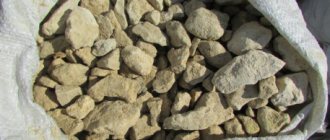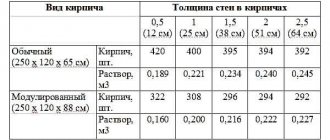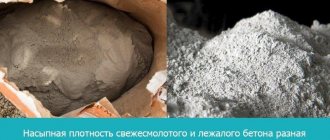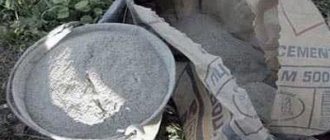A developer who is planning to build on his own will definitely face the problem of quickly and accurately dosing materials for preparing concrete or mortar. The brand of the mixture must exactly meet the requirements of the technology - it is impossible for the mortar or concrete to be less durable than required. On the other hand, using more expensive mixtures where they are not needed will lead to unjustified expenses, so you need to be able to quickly and accurately prepare a mortar or concrete of the required grade using simple available means. We will tell you how to properly dose materials for preparing these mixtures.
How to calculate the volume of packaged cement
Manufacturers indicate information on the packaging container or in accompanying documents as the ratio of mass to volume.
Cement mortar
Having determined the volume of 1 kg of cement composition, you can calculate 50 kg.
1: 1300 = 0.0008 0.0008 x 50 = 0.04 cubic meters
Arithmetic calculation differs from practical calculation in the yield of the finished solution.
The value is affected by:
- binders
- sand
- crushed stone
- water
- shrinkage
Therefore, as a result, fluctuations in kilograms of the resulting mixture are possible. There are some things to consider. When you take components for making cement powder, their volume is less than the prepared substance.
The result is obtained from the influence of the technological process:
- grinding ingredients
- mixing with each other
- formation of air gaps between grains
These properties distinguish substances in a state of absolute density from bulk density, in which there are pores and air between the particles.
Therefore, the manufacturer indicates the last value on the container; it is used when determining volumes. Fresh cement has a lower density, which means the output is large volume and small mass.
How many kilograms are in a liter of cement?
Mass is a characteristic of a body, which is a measure of gravitational interaction with other bodies.
Volume is a quantitative characteristic of the space occupied by a body, structure or substance.
Density is a physical quantity defined as the ratio of body mass to body volume.
The relationship between liters and kilograms of cement is determined by a simple mathematical formula:
V—volume; m—mass; p—density.
In the calculation, the density of cement was taken = 1300 kg/m3.
The density of cement can vary depending on temperature and pressure. You can find the exact density of cement in reference books.
See also the universal program for converting liters to kg for any substance depending on its density.
If you need to convert m3 to tons, then see the program for converting tons to m3.
If you need to convert kg to m3, then see the program for converting kg to m3.
Question: How many kg are in a liter of cement?
Answer: 1 kg of cement is equal to 0.769 liters.
Question: How many liters are in a kilogram of cement?
Answer: 1 liter of cement is equal to 1.3 kilograms (kg).
You can quickly solve this simple mathematical operation using our online program. To do this, enter the initial value in the appropriate field and click the button.
This page provides the simplest program for converting kilograms of cement to liters. Using this online calculator, you can convert liters of cement to kg and back in one click.
Source
Additional recommendations
It should be borne in mind that each individual mixture may contain a different number of components and their ratio or quality. Thus, it is quite difficult to accurately determine the weight; only approximately take as a basis the average statistical data based on the brand of the mixture.
Not only the amount of sand matters, but also its fraction. Fine-grained sand is heavier than coarse sand. An increase in voids, with a large fraction, leads to a lighter weight of the entire solution. It is generally impossible to calculate a solution prepared by yourself, since each batch will be slightly different from the previous one.
Similarly, with a larger brand, less mixture will be needed per 1 m2. So, when filling the site, you can use other brands instead of M300, both M200 and M400, the results will differ slightly.
The freshness of the cement plays an important role. If the cement was produced more than 1 month ago, then its characteristics are slightly reduced, by approximately 10-15%. Thus, a little more cement is added to the solution.
Drying the solution from the moment of preparation takes about 1-1.5 hours. Subsequently, it ceases to be suitable and begins to form into a single whole. Even adding water will not restore the proper elasticity of the mixture.
Amount of solution per cubic meter
It is necessary to understand that the proportions and content of cement and CPS in a dry state were previously calculated. When water is added, the entire composition becomes significantly denser, which leads to a decrease in its volume. It is always worth considering the shrinkage coefficient of cement due to the mixture with water; the approximate proportion is 1 to 1.4.
The correct ratio of sand, cement and water can make any structure as strong and durable as possible . The solution should be mixed well and the moisture level should be controlled; there should be enough of it to ensure the plasticity of the CFRP, but not too much for concreting, otherwise everything will spread.
If we return to the previously given example, the calculation will look approximately as follows:
- (35 m3 (cubic capacity of the area to be poured) / 0.307 m3 (200 kg of mixture, where 50 kg of cement and 150 kg of sand)) * 1.4 (water shrinkage coefficient) = 114 bags;
- 35 m3 (cubic capacity) / 0.038 m3 (part of a 50 kg bag of cement in 1 m3) = 921 bags - this is exactly the amount that can fit in 35 m3 of space.
Thus, it turned out that to fill a room with an area of 175 m2 and a layer depth of 20 cm, 114 bags of M300, M400 or M500 cement will be required.
For more information on how to calculate the solution, watch the video:
What is the volume of cement in a bag weighing 25 and 50 kilograms, what does the volume depend on?
Cement is a binding powder building material. It has hydraulic properties. It consists of clinkers, derivative additives of gypsum compounds, as well as binders.
The main components of these substances are calcium aluminates and silicates. When combined with water, this powder turns into cement paste, and after hardening into stone.
What does volume depend on?
This indicator depends on the following factors:
- From density. During the production of mortar powder, each particle receives an electrical discharge. Thanks to this, the powder does not stick together. But this effect of this property gradually decreases, the compaction of cement increases, and its friability decreases.
- From production technology. The amount of powder is determined by the size of the particles and the distance between them. The larger the particles, the greater this value.
- From the view. The volume of the powder depends greatly on its composition.
- Depending on the storage method used. When stored in a damp room, this cement indicator increases.
- Depending on the type of brand. A powder of a higher grade has a correspondingly higher density, therefore, a smaller volume.
Density
Density is the ratio of mass to its volume.
In the construction industry, there are two types of density:
- Bulk. This value is measured with special equipment when the powder is in a crumbly state. These measurements are necessary to determine the number of components when loading them into a concrete mixer.
- True density differs from bulk density with the exception of air components from cement. In construction practice, the average value between bulk and true is used for calculations.
Kinds
The industry produces the following types of cement:
- Fast-hardening Portland cement. This type is enriched with various special additives that guarantee an increase in strength in a short time.
- Mixture with hydrophobic additives. Solutions with such additives practically do not absorb and are not washed away by water. This composition is used to construct objects located near water bodies or in flood zones.
- Solution with PAD. Has improved stackability. Used when working with complex architectural facades.
- Backfilling. Used for securing various parts in the oil and gas industry.
- White and colored mixtures. Used for architectural and finishing works.
Brand
The brand of this material contains the values of the load it can withstand, as well as information about the additives used. The letter M determines the compressive strength of the mortar; it varies from 100 to 700.
The remaining letters indicate various additives:
- PC-Portland cement.
- BC-white composition.
- B-fast-hardening solution.
- PL is a mixture with plasticizers.
- ShPTs is a solution with slag additives.
When using various impurities, they achieve changes in certain properties in the solution and give it, depending on the conditions:
- Frost resistance.
- Moisture resistance.
- Corrosion resistance, etc.
Cement bag volume
In retail stores, this building material is usually sold in 25 and 50 kilogram packages. The amount of mixture in the bag may vary depending on conditions. The fact is that this value is inversely proportional to density.
From one bag of cement, depending on the volume, different amounts of solution are obtained:
- A 25 kilogram bag – 0.019 m3 of solution.
- A 50 kilogram bag – 0.038 m3 of solution.
How many buckets are in a bag?
The amount of cement inside the bag is affected by its density, which can vary depending on the degree of compaction and humidity. Typically the density is in the range from 1000 to 1600 kg/m3. The most commonly used average is 1300 kg/m3. This means that 1,300 kilograms of powder are consumed per 1,000 liters of water. Knowing this proportion, you can calculate the powder consumption for any volume.
This material is produced by industry with different properties and characteristics. When carrying out construction work, depending on weather conditions, you need to be able to correctly determine the required type of powder.
Bulk density of cement
To determine how many kg of cement are in a 10 or 12 liter bucket, you must first find out the bulk density of the material. Usually the parameter is indicated in the quality certificate or in the instructions on the bag itself. Knowing the bulk density, it is not difficult to perform calculations.
- The shelf life of the powder - the material only from the factory shows a value of 1100 kg/m3. During the grinding process, the particles of the material receive a static charge of the same sign, and therefore repel one another. The voids are immediately filled with air. But during transportation and storage, the static charge disappears, the cement becomes denser and the indicator can even increase to 1600 kg/m3.
- Features of production technology - this factor determines the size of air voids, the size of powder fractions, etc.
- The composition of the material is limestone, slag, microsilica, etc. They reduce the cost of cement, but also the density (and strength at the same time). Only Portland cement does not contain mineral additives, and in this case the bulk density is equal to an average of 1300 kilograms per cubic meter.
To obtain the desired indicator, it is enough to multiply the bulk density by the volume of the vessel. 1300 kilograms per cubic meter is 1300 grams per cubic centimeter.
1300 grams x 10 (liters) = 13000 grams = 13 kilograms holds one 10-liter bucket of Portland cement with a density of 1300 kg/m3. Knowing the density, you can not only determine how much cement is in a 10-liter bucket, but also calculate the mass of dry powder in any container. So, for a 12-liter bucket the calculations look like this: 1300 x 12 = 15600 = 15.6 kg.
Basics of calculations
Cement is the main component of a concrete mixture, since it tends to firmly bind the other components. Such material affects the main indicators - moisture and frost resistance, strength. If you allow deviations in mixing the solution, then the errors will negatively affect the composition. This will lead to poor quality raw materials.
Some time after production, cement powder begins to lose its beneficial properties. For this reason, it cannot be purchased long before construction work begins.
To carry them out, it is important to know how much cement is needed for a cube of concrete, based on the selected type and brand of material
To obtain a high-quality batch, the following is also added to its composition:
- sand;
- water;
- crushed stone
Without these two components, the solution will not have all the necessary properties. Crushed stone is a fairly strong stone, so it can bind the composition more firmly. Thanks to it, concrete does not crack, regardless of weather conditions. To prepare 1 cube of concrete, you need to take 1.08 tons of crushed stone. Moreover, for the best fraction of the composition, it is recommended to add pebbles with a diameter of no more than 20 mm. They are usually sifted through a sieve with special cells.
Volume of a bag of cement for various types of work - consumption
Depending on the purpose of cement, it comes in different grades and its density, consistency, and amount of additives differ. Also, for some types of work it is quite difficult to calculate the cubic capacity of cement, for example for masonry.
So for masonry, a mixture with grades from M100 to M300 is used. The required strength can be determined based on the height of the building and the brand of brick. If you make seams in accordance with regulatory rules, then there is also an approximate consumption of the solution in order to determine the amount of cement purchased.
Our article will tell you about the consumption of cement per 1 m2 of screed.
Consumption of components for masonry
It should be noted that in masonry a mixture ratio of 1 to 4 is often used . The main factor influencing the amount of mortar is the thickness of the wall.
So for thickness:
- 1 brick uses about 0.19 m3;
- for 2 bricks – 0.22 m3;
- for 3 bricks – 0.234 m3;
- for 4 bricks – 0.24 m3;
- for 5 bricks – 0.245 m3.
Based on these parameters, you can find out the required number of cubes of cement mortar. It must be remembered that a liquid solution is indicated here.
When plastering the surface, you should pay attention to the amount of impurities, and they are used both in factory packaging and manually.
Quite rarely, decorative plaster is made with a standard mixture; plasticizers are added to give elasticity.
Plaster surface
They can be special additives with a special effect, or manually add slaked lime or clay. These components occupy a certain proportion of the mixture and must be taken into account.
How to calculate how many buckets of cement are in a 50 kg bag
Having information at hand opens up an undeniable advantage for the master - the ability to easily and quickly calculate proportions during concrete preparation. In addition, this is an excellent opportunity to easily calculate how much cement is contained in a bag and convert the volume into buckets.
Features of cement packaging
Traditionally, cement is packaged in multilayer paper bags (bags) with a capacity of 50 kg. But focusing on the solvency of the population and the needs of customers, 90% of companies began to produce packages weighing 20, 25, 35, 42, 46 kilograms.
Therefore, taking into account the above, a person can easily get confused with the choice of packaging of the required packaging, and this threatens to cause problems with preparing the solution. Therefore, before purchasing, check how many buckets of cement are in a 50 kg bag, if it is more convenient to select the proportion.
As mentioned, traditional packaging in 50 kg bags is the most convenient and common. This is the optimal packaging for manual loading work. Therefore, it is more profitable to purchase dry material in this form. For work, you can choose a product from any manufacturer with the necessary technical characteristics.
How to calculate how much material is in a bucket?
Fresh cement is a loose dry mixture consisting of dust microparticles and microscopic air inclusions that fill the voids between them.
In a loosened state, cement is characterized by an average density of 110-1600 kg/m3. This parameter determines the percentage of dry mixture in the prepared solutions, which ultimately affects the strength and speed of concrete hardening. The density of the substance depends on how many buckets of cement are in a 50 kg bag.
How to measure material in liters?
Please note that the density indicator must be indicated on the packaging. To simplify calculations, the density of cement is taken to be approximately an average value of 1190 kg/m3. This means that in a standard paper bag (50 kg) the volume of material is 42 liters
This means that in a standard paper bag (50 kg) the volume of material is 42 liters.
From here we calculate how many buckets of cement are in a 50 kg bag. For packaging in half a quintal, the volumes given in the table below are valid.
| Bucket capacity (l) | Number of cement buckets in a bag 50 kg |
| 10 | 4,2 |
| 12 | 3,5 |
| 16 | 2,6 |
When preparing concrete mortar, it is more convenient to use containers than to take measurements (weighing) and struggle with proportions. Therefore, knowing how many buckets are in a 50 kg bag of cement, you can prepare the solution faster and with better quality.
Neither domestic nor industrial construction is complete without the use of concrete mortar. The basis for the production of concrete is a cement mixture consisting of a number of components. In the process of mixing bulk material from bags, sand, gravel or fine crushed stone and water, concrete is obtained. It is prepared depending on the need and scope of application and used only for its intended purpose.
An example of calculating material in buckets for 1 bag (50 kg)
Let's take a 35 kg bag. According to the formula, we divide the weight of the package by the density: 35: 1.19 = 29.4 liters - that is, almost three ten-liter buckets. Accordingly, if you take a 20 kg bag, the volume will be 16.8 liters - one full sixteen-liter bucket of cement.
Important! Please note that the proportions are rounded down, since the finished solution does not contain air, and the volume of cement in liters depends on the density of the dry material and is calculated using the formula
It is better to purchase cement with an average density (1190 kg/m3), and when purchasing, pay attention to the date of manufacture. The compacted material has a higher density (1500-1600 kg/m3), and lower quality characteristics, which is why there is a significant consumption of material. Now you know how many buckets are in a bag of cement and how to calculate the volume of cement in buckets when going to a hardware store
The ability to calculate the volume of material allows you to save on the purchase of material. After all, you don’t risk spending money on bags of mixture, which in the end will turn out to be superfluous and will stand until it petrifies
Now you know how many buckets are in a bag of cement and how to calculate the volume of cement in buckets when going to a hardware store. The ability to calculate the volume of material allows you to save on the purchase of material. After all, you don’t risk spending money on bags of mixture, which in the end will turn out to be superfluous and will stand until it petrifies.
Calculation of the amount of solution in one unit of container
The manufacturer indicates the technical characteristics of the construction product on the packaging.
Therefore, for its preparation at home, a product from any manufacturer is suitable. The main thing is to understand the specific density of the material and the packaging size. This will make it easier to calculate the number of buckets of cement in a 50 kg bag. In powder form, the building mass has a density of 1100 – 1600 kg/m
3
. The numbers vary depending on the brand, freshness and amount of additives. The percentage of bonding powder in the finished building mixture depends on these data. The strength of the structure and the drying time of concrete are influenced by the composition of the material, so it is important to calculate how many 50 kg buckets of cement are in a bag.
The concrete mixture is prepared independently from the following components:
Making concrete mixture from cement
- loose bonding powder;
- sand;
- gravel or fine crushed stone;
- water.
The maximum density is taken to be 1300 kg/m
3
. The following result is obtained: in a 50 kg package, the contents of the finished mixture will be 42 liters. Knowing the capacity of the existing container, you can calculate the required number of packages when purchasing.
How much concrete will be produced from 50 kg of cement?
SNiP regulates the amount of binder when hardening concrete under natural conditions:
- minimum content in unreinforced structures - 200 kg/m³;
- in reinforced ones - 220 kg/m³.
The optimal content is determined by multiplying the typical content by increasing factors associated with the size of the aggregates. In individual construction its value does not exceed 1.15. Typical standards are shown in the table:
The workability of a concrete mixture is an indicator characterizing the plastic properties of the material. In the table, select the lower flow rate in the corresponding column.
Now you need to do the reverse calculation. The minimum consumption of binder in unreinforced products is 200 kg per cubic meter. Accordingly, 50 kg of cement will be contained in:
50/200=0.250 m³ with a filler fraction of 20 mm (crushed stone) and a sand fineness modulus of 1.5.
In reinforced concrete this value is:
The recommended quantity of PC M500 for the most popular concrete M300 is 250 kg. One bag of such cement is enough to prepare:
50/250=0.2 m³ of mixture.
Ratios for solutions of other brands:
- M150 - 50/200=0.250 (use PC M400)
- M200 - 50/200=0.250 (PC M500)
- M250 - 50/220=0.227
- M350 - 50/290=0.172 m³.
Examples of calculations
The dimensions of the monolithic structure and its volume are determined in the drawing or in kind.
Example 1. It is required to pour a foundation 0.5 m deep, 0.3 m wide and 20 m long. The volume of the structure is:
The material used is PC M500, the required grade of concrete is M200. One bag is enough to make:
50/200=0.25 m³ solution.
Required number of 50 kg bags:
Thus, twelve bags will be required to complete monolithic work.
Example 2. Construction of a garden path 10 m long, 0.6 m wide and 10 cm thick.
Volume of concrete cover:
The grade of concrete for such structures is M150, and Portland cement is M400. From one bag you can make 0.250 m³ of mixture. To build a path you will need:
0.6/0.25=2.4 packages weighing fifty kg. In order not to buy extra material, you can purchase two bags of 50 and one weighing 25 kilograms.
Tables for calculating Portland cement consumption
Depending on the brand of concrete and cement, it is easy to determine how many 50 kg bags of PC are in a cube of the mixture. The exact need for binder is determined using a ready-made table:
How much does a bag of cement weigh?
Average cement in terms of characteristics and transportation/storage features shows a specific gravity of 1300 kg/m3. Therefore, a standard 50 kilogram bag holds about 0.038 m3 of material.
Interesting materials:
How to find out the IMEI of the phone on the box? How to find out the IMEI of a locked Xiaomi phone? How to find out the Bluetooth name on your phone? How to find out the IP address of the access point on your phone? How to find out the ip of someone else's router from your phone? How to find out how you are subscribed to others on your phone in Getkontakte? How to find out what Honor phone model is? How to find out what phone model a person has? How can I find out what subscriptions are on my phone? How to find out what 4G is on your phone?
Cement production
The cement production process is based on grinding clinker followed by the addition of gypsum. Clinker is mixed from a mixture of clay and limestone and sintered until a moisture content of 18% is achieved. Gypsum is included in the composition to speed up the hardening process. Also, to impart certain properties to the cement mixture, sand, bauxite, and pyrite cinders are added. The introduction of additives reduces the cost of the final product. The mixture of raw materials is placed in a special rotary kiln, where firing is carried out for four hours at a temperature range from 1450 to 1480 °C. During firing, organic compounds burn out, clay components dehydrate and decompose. Limestone decarbonizes when exposed to heat, calcium compounds sinter, forming calcium silicates. When the mixture cools, part of the liquid phase solidifies to form glass, while the other part crystallizes.
Cement bag dimensions
To transport and store cement, you need to know the external dimensions of the container.
Thanks to this data, you can determine what kind of transport will be needed for transportation or how much space will be required in the warehouse. There are two main types of bags: glued and sewn. The former are mainly used for packaging cement, since with their help it is possible to minimize losses during transportation. The size of a standard bag of cement weighing 50 kg is 60 * 49.5 * 9 cm . There is another, quite popular variety of such containers. Its dimensions coincide with the standard in everything except the height parameter, it is equal to 13 cm. This difference is primarily explained by the number of layers of paper (5 - 6) and its density (45 - 120 g/m²).
The second most popular is cement, packaged in 25 kg packs. The external dimensions of the bag will be 44*38*9 cm. The latter indicator, as in the first case, can be increased depending on the number of layers, density and method of manufacturing the container.
Recently, for the convenience of packaging, kraft bags have become the most popular, as they have a valve that closes under pressure. For example, the external dimensions of a non-standard bag of cement weighing 40 kg are 58*45*11 cm. Such containers are mostly made to individual orders.
Due to the fact that cement is a substance that is easily susceptible to external influences, the main requirement for bags is good air tightness. This is why thicker and more layered bags are considered better.
Source
Sand in bags of 50 kg. Features, advantages and disadvantages.
The value of sand in construction and production is determined not only by its fraction size and origin. When organizing work, the ability to accurately calculate the amount of material is of great importance, especially when it comes to precise dosing, for example, in the production of dry mixes and plaster compositions
In the production of concrete products, when it is necessary to obtain a solution with precisely maintained characteristics, it is very important to supply sand, measuring its amount in advance
Packaging sand in 50 kg bags
Sand in 50 kg bags is actively used in road construction and when pouring the foundations of private houses. This dosage allows you to make a simple conversion from kilograms to tons, convert the volume to cubic meters. However, a bag of such weight and volume is not convenient for all consumers. This form of packaging has a set of advantages and disadvantages that must be taken into account when choosing:
- the bag is heavy compared to other types of packaging - this creates difficulties during unloading and storage, since the load on the pallet is limited, and when placing a large batch, an increase in the area of the covered warehouse will be required;
- when dosing the supply of sand, a situation arises when you have to re-weigh it, because a small amount is required - sand in 25 kg bags makes it possible to measure out the required amount more accurately and without additional actions;
- If a bag or pallet is damaged, damage to sand in large bags is more likely due to their weight;
- the large volume and significant weight of the material in the packaging require an increase in the strength of the bag, and this affects the increase in gross weight, which causes additional difficulties in calculating transportation costs.
There is another interesting feature that specialists who work with modern equipment and mixtures know about. Often the dosage of materials for automatic lines is specified in pounds - and this creates difficulties in conversion. Sand in 40 kg bags is a very convenient solution for such cases, since this weight is closest to calculations in pounds (one pound is approximately 400 grams) (you can order such a weight distribution at).
The advantage of bagged sand
All work involving the use of sand requires taking into account its quality, and the assessment is based on several criteria. Some of them are static—the grain size (fraction), the chemical composition of the grain, and compressive strength. But there are bulk density indicators that are used to calculate the purchase of sand in cubic meters. In construction practice, an accurate conversion from tons and kilograms to cubic meters can be made using a simple principle - knowing the bulk density of washed river sand at a humidity of 4-7%, you can take approximately 1450 kg of sand per cubic meter as a unit of weight/volume.
The problem with a more accurate calculation is the need to take into account the real moisture content of the material, since when this indicator increases to 10%, the mass density decreases sharply. And when the humidity reaches 17-20%, a new relationship with volume arises - the weight of the water trapped in the mass of sand changes the ratio again. If we are talking about the purchase of a large batch of river construction sand, then losses from such changes in the humidity of the bulk material can be very serious.
When transporting sand in bulk, a scattering effect occurs, which cannot always be prevented even with the use of tilt dump trucks. Packaging sand in 40 kg bags makes it possible to get rid of the undesirable consequences of changes in humidity, dispersal, and clogging of sand with dust during storage in bulk.
Bulk or in bags? — how to order sand
The purchase of packaged sand for construction and production purposes creates conditions for optimizing its use at all stages - from removal from the place of purchase to storage and transshipment from warehouse to production. Transporting a pallet with bags with a forklift is much more convenient than transferring a large mass with a dump truck or front loader. In general, using sand in bags - in prepared hermetically sealed and durable containers - is a modern solution for those cases where good preservation, constant quality of the material and ease of transportation, storage and technological movement are needed.
fleet-nerud.ru
What is the importance of correct calculations
Cement mortar is often used for the construction of houses and repairs of massive objects, residential and non-residential building stock, as well as for minor work around the house.
As a rule, when repairs begin, an ordinary person does not know all the intricacies of calculations . He is not able to combine the amount of material used that is necessary to complete the construction work. This entails additional money spent and a waste of time.
You can roughly calculate the amount of material that will be needed. The basis here is the area of the object being processed. With cement the issue is much more difficult.
Decorative plaster "Bark beetle" began to be used quite often during the finishing of houses and various buildings. Here is the technology for applying it.
Frost-resistant tile adhesive can be used both outside and inside unheated rooms. Here is everything about the composition and popular manufacturers of this material.
Cement is the main building material in the manufacture of reinforced concrete and concrete products, as well as various mortars. By clicking on the link you will learn what cement is made from.
The container does not indicate the percentage of water in which the material in question should be diluted; the packaging displays only the weight of the mixture, which is in dry, powdery form.
But all recommendations and tips for carrying out repair work indicate the ratio of mortar in the equivalent of the container required for you.
Accordingly, in order to prevent unnecessary waste of money and time, it is necessary to carry out independent calculations of the amount of dry cement that is needed to prepare the solution. Powdered cement cannot be stored for long.
As a result of prolonged exposure to a room with high humidity, or when the bag is left open for a long time, the cement cakes and becomes an unusable lump.
In this case, it can no longer be used for construction and repair purposes. Therefore, at the stage of screeding the floor, concreting a garden path, creating a foundation for a future structure, or laying bricks, it is simply necessary to carry out all the calculations regarding the amount of cement mortar required.
In this case, it is not the weight that should be taken into account, but the volume.
Calculation of the number of bags of sand concrete in 1m3
Typically, the cement mixture is poured into rectangular formworks, the volume of which is not difficult to calculate: just multiply the cross-sectional area by the length of the channel. Even with the most accurate calculations, errors may occur. Experts advise making a small test portion of the solution and pouring it in first. In this case, it is necessary to remember how much powder was spent and the volume that it ultimately occupied. Knowing this data, you can quickly and accurately fill the formwork.
Types of cement
When making calculations, it is important to consider the type:
- Portland cement;
- Portland slag cement;
- magnesian;
- alumina.
You may also be interested in the article Cost of cement per 50 kg bag.
All types have different composition, density and volumetric weight in kilograms per cubic meter:
| Wood group by specific gravity. | The wood density for this type of wood is kg/m3. | How much does a 25 liter bag of sawdust weigh? | volume 30 liters. | How much does a 40 liter bag of sawdust weigh? | ||
| How much does a 50 liter bag of sawdust weigh? | volume 60 liters | |||||
| First group. Low specific gravity of wood is spruce (all c. spruce), pine (all c. pine), fir (all c. fir), cedar (all c. cedar), common juniper, poplar (all c. poplar), linden (all linden trees), willow (all willow trees), aspen, black alder and white alder, chestnut, white walnut, gray walnut and Manchurian walnut, Amur velvet. | up to 540 | until 13.5 | up to 16.2 | until 21.6 | up to 27 | up to 32.4 |
| Second group. The average specific gravity of wood is larch (all types of larch), yew, silver birch, downy birch, black birch and yellow birch, eastern beech and European beech, elm, pear, summer oak, eastern oak, swamp oak, Mongolian oak, elm, elm, maple (all maple), hazel, walnut, plane tree, rowan, persimmon, apple tree, common ash and Manchurian ash. | from 550 to 740 | 13.8 — 18.5 | 16.5 — 22.2 | 22 — 29.6 | 27.5 — 37 | 33 — 44.4 |
| Third group. The high specific gravity of wood is white acacia and sand acacia, iron birch, Caspian honey locust, white hickory, hornbeam, chestnut oak and Araxinian oak, ironwood, boxwood, pistachio, hop hornbeam. | over 750 | over 18.8 | over 22.5 | over 30 | over 37.5 | over 45 |
| Name | Bulk density | True |
| Portland cement | 1300-1500 | 3100 |
| Aluminous | 1000 | 3000 |
| Slag Portland cement | 1100 | 3000 |
All values are as close as possible to the technical design standard ONTP-07-85.
How to determine density yourself?
This is useful for companies engaged in construction on a permanent basis. The density of cement is initially unknown, and may decrease over time under the influence of various factors:
- moisture absorption;
- passive reduction due to deelectrification of cement dust particles;
- penetration of air into the composition;
- violation of storage conditions.
The longer a bag of cement is stored in a warehouse, the more its bulk density decreases. As a result, over time there is a need to recalculate the characteristics.
To do this, you will need a container (for example, a bucket) with a known volume and a funnel. The algorithm is simple:
- Fill the container to the brim through a funnel, remove excess.
- Weigh.
Now you need to subtract the mass of the tank from the weighing result and divide by the volume of the container. For reference: 1 liter is equal to 1 cubic decimeter.
Calculation example:
- Weighing showed 14 kg.
- It is known that the bucket is 10 liters.
- Divide 14 kilograms by 10 liters, we get 1.4 kg per liter, or 1400 kg/cubic meter.
How to properly store cement packaged in bags?
If construction work is postponed for a long period, it is necessary to ensure proper storage of building materials. For Portland cement and slag cement the conditions are the same:
- The bags must be placed on pallets.
- The room should be dry and well ventilated.
- The integrity of the bags is not compromised. Air along with moisture penetrates through the holes and causes deformation of the mixture.
- The expiration date has not been exceeded. Otherwise, you can expect a decrease in the strength of the hardened composition by 20-40%.
Cheap and low-quality cement deteriorates even under ideal storage conditions and loses its volumetric weight over time. For convenience, it is recommended to save the markings on the bags or write them down in a separate notebook.
What size is a sugar bag?
Polypropylene bags, sugar bags
| Size | Capacity | Weight |
| 55×105 | 50 kg | 75 gr |
| 55×105 | 50 kg | 85 gr |
| 60×120 | 70 kg | 100 gr |
| 50×90 | 50 kg (with salt) | 60 gr |
Interesting materials:
Which roses are short? What roses are groundcover? What kind of handles should I put in the kitchen? What fish can live in a 5 liter aquarium? What fish can live in a small aquarium? What kinds of garden flowers are there? What napkins are best for cleaning? What kind of self-tapping screws for aerated concrete? What kind of drywall screws for the profile? What kind of screws for gypsum boards?
Number of bags of cement in 1 m3 of ready-made cement mortar
By analogy with considering the question of how many bags of cement are in a cube of concrete, let’s first ask ourselves the initial data:
- Cement-sand mortar grades: M75, M100, M150, M200.
- Portland cement CEM I 32.5N PC (M400) and CEM I 42.5N PC (M500), packaged in multilayer paper bags.
- Net weight of bags: 25, 50 kg.
To determine the value - how many bags of cement are in a cube of mortar, we will use tables of proportions of concrete components in kilograms, compiled by analogy with tables of proportions of components for preparing concrete.
Table of proportions and quantities of components per 1 m3: Portland cement CEM I 32.5N PC, sand, water
| Concrete grade | Proportion, C:P:W | Cement, kg | Sand, kg | Water, l |
| M75 | 1:5:1 | 285 | 1390 | 285 |
| M100 | 1:4:0,8 | 338 | 1345 | |
| M150 | 1:2,8:0,6 | 450 | 1265 | |
| M200 | 1:2:0,5 | 560 | 1185 |
Table of proportions and quantities of components per 1 m3: Portland cement CEM I 42.5N PC, sand, water
| Concrete grade | Proportion, C:P:W | Cement, kg | Sand, kg | Water, l |
| M75 | 1:5,5:1,1 | 260 | 1405 | 285 |
| M100 | 1:4,5:0,9 | 305 | 1375 | |
| M150 | 1:3,3:0,7 | 400 | 1300 | |
| M200 | 1:2:0,5 | 495 | 1230 |
An example of calculating the value is how many bags of cement per 1 cubic meter of M200 solution based on Portland cement CEM I 42.5N PC: 495/50 = 9.9 bags weighing 50 kg; 495/25=19.8 bags weighing 25 kg.
Answers to other common questions from private developers
- How many cubes are in a 50 kg bag of cement and how many cubes are in a 25 kg bag of cement? The average specific gravity of 1 m3 of cement, accepted by all concrete plants as a value for practical calculations, is 1,300 kg/m3. Accordingly, in a 50-kilogram bag of cement: 50/1300 = 0.038 m3 of cement, and in a 25-kilogram bag: 25/1,300 = 0.019 m3 of cement.
- How many cubes of concrete can be obtained from a bag of cement weighing 50 or 25 kg? The number of cubes of concrete that can be prepared from the specified bags of cement depends on the brand of concrete. Let's consider as an example the most popular brand of concrete - M200 based on CEM I 32.5N PTs cement. To calculate using the table value of the amount of M400 cement required for the preparation of concrete grade M200 - 255 kg. We compose and solve the proportion: 50 kg x 1 m3/255 kg = 0.19 m3 and 25 kg x 1 m3/255 = 0.098 m3 of concrete, they will be 50 kg and 25 kg of a bag of M400 cement, respectively.
Similarly, using the above tabular data, you can calculate how many cubic meters of cement-sand mortar a bag of cement weighing 50 and 25 kg will be enough for.
Proportions of cement solutions
The weight of the bag is always indicated on the bag itself, but the density of cement can change even within the same substance stored for different times. Therefore, you need to be able to convert some quantities into others and vice versa.
So, to mix a mortar from M500 cement, you need to take the following proportion: 1 part cement, 2 parts sand, 4 parts crushed stone. From the ratio you can determine the volumes of each of the components: to do this, take the total volume of the solution that needs to be obtained and divide it by the number of parts. So, if you need to get 1 cubic meter of solution, then per part there will be 1:7 = 0.142 m3. One part of any of the components is equal to this indicator.
- 1 part of cement – 0.142 m3.
- 2 parts sand – 0.284 m3.
- 4 parts of crushed stone – 0.568 m3.
To obtain values in kilograms, you simply need to use the bulk density of each material, multiplying by the desired volume. So, if 1m3 of M500 cement contains 1500 kilograms of material, then in this case you need 1500x0.142=213 kilograms of cement, 1800x0.284=511 kilograms of sand, 1400x0.568=795 kilograms of crushed stone. Water takes up half the volume of cement.
To find out how many bags of cement you need to buy, simply divide the required number of kilograms by the weight of the bag: 213/50 = 4.26 bags of 50 kilograms, 213/25 = 8.5 bags of 25 kilograms, 213/40 = 5.32 bags of 40 kilograms.
Mixture recipes can be different; when choosing, two main factors are taken into account: the brand of binder used (should not be much lower or higher than the desired brand of concrete), the purpose of the solution (for pouring a foundation or floor, laying bricks, plastering, creating products, etc. ).
According to GOST, the main compositions are prepared according to the following recipes:
- To prepare M100 grade concrete, use: 1:4.5:7 (M400 grade cement, sand and crushed stone) or 1:5.8:8 (with M500 grade cement).
- Concrete M250: 1:2:4 (cement M400) and 1:2.5:4.5 (cement M500).
- Concrete M400: 1:2:3.7 (from M400 cement) and 1:1.5:3.2 (from M500 cement).
The following rule works here: the higher the grade of cement, the less fillers are added and the lower the specific gravity of a cubic meter of finished concrete.
Specific gravity of cement M500
The concept of specific gravity defines the ratio of the weight of a bulk or other substance to the volume being replaced. The meaning is somewhat similar to what many mean by density
In construction, it is quite important to know the specific gravity of cement M500 or another brand, since this indicator determines many performance qualities
The characteristics of bulk materials determine that their specific gravity can differ significantly depending on the state. For example, the volumetric weight of M500 cement in its fresh state is much less. This is due to the fact that during the process of intense friction at the time of production, the particles rub against each other and tension arises, which pushes them apart.
After long-term transportation or storage, the weight of a cube of M500 cement increases significantly. This is due to the loss of the charge in question and the air cushion disappears. Powdery substances begin to thicken over time.
According to research, the bulk density, which affects the weight of a bag of M500 cement, can be as follows:
- The fresh weight of 1 m3 of m500 cement is calculated assuming a density of 1100-1200 kg/m3.
- Long-term storage or transportation increases the density to 1500 kg/m3.
These nuances should be taken into account when calculating specific gravity.
Average bulk density of components and materials for concrete
Despite the simplicity of performing calculations using the method indicated above, it is not always possible to use it. The thing is that the bulk density of the material can change and is not always known exactly.
- Loose cement – 1100-1200 kg/m3
- Compacted cement – 1500-1600 kg/m3
- The average for cement is 1300 kg/m3
- Average for sand -1400 kg/m3
- Slag crushed stone – 800 kg/m3
- Fine gravel – 1700 kg/m3
These are average figures; to make accurate calculations, it is better to find out the parameters of specific building materials. Then it will be possible to most accurately determine how many kilograms of cement, crushed stone, sand are in one 10/12-liter bucket.











